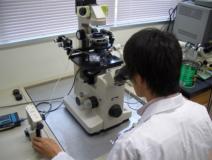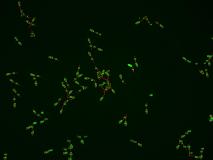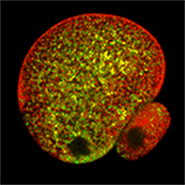Animal Development and Reproductive Biotechnology
Staff
Research Topics
We are developing new more effective IVF systems and micromanipulation techniques for gametes in mammals including humans. Through these technological developments, we are also undertaking basic studies to make clear the systems of gamete (oocytes and spermatozoa) formation, fertilization and early development, as well as applied studies to improve the efficiency in the production of more value-added useful animals. The details are as follows.
Development of new systems to produce embryos in vitro from oocytes collected from small diameter follicles

For in vitro embryo production in mammals, especially domestic animals, usually oocyte-cumulus complexes derived from middle follicles with a diameter of 3-6 mm have been used. However, a large number of small follicles with less than 3 mm in diameter, rather than middle follicles, exist on the surface of ovaries. But the developmental competence of the complexes from small follicles (in meiosis and early development following fertilization) has been known to be much lower than those from middle follicles. We're trying to make clear why the developmental competence is lower in the oocytes from small follicle as compared with middle ones and whether those abilities are improved when what kind of processing are applied. |
New assessment of sperm quality and the function associated with penetration

In mammals, although a quite large number of spermatozoa are ejaculated into the female reproductive tract before ovulation, consequently only one spermatozoon will be able to penetrate into an ovulated oocyte. So far, sperm function and the quality has been assessed as the motility and membrane intactness of spermatozoa under a microscope. However, this assessment may not be ideal in objectivity and may require quite expensive equipment such as a flow-cytometer. So, we are focusing on the work of the mitochondria and RNA in spermatozoa to make clear the mechanisms regulating the function and maintaining the quality of spermatozoa. We are also applying the knowledge to sperm assessment. |
Roles of organelles in mammalian oocytes

Gametes (oocytes and spermatozoa) are highly specialized cells for the transmission of genes to the progeny. Our laboratory is interested in understanding the mechanisms of oocyte development, maturation and fertilization in mammals. Problems in oocyte quality cause the infertility, and the development of organelles, such as mitochondria and endoplasmic reticulum, is a key determinant for the successful fertilization and subsequent embryonic development. We are using several techniques to address the roles of organelles in oocytes including in vitro maturation, fertilization, genetic manipulation and live cell imaging. |
Publication List
- Ferré-Pujol P, Otsuki J, Funahashi H, Nakatsuka,M. The Thickness and Density of the Ovarian Tunica Albuginea Increases with Age in Transgender Patients. Reprod Sci. 28(5):1339-1346, 2021.
- Moros-Nicolás C, Izquierdo-Rico MJ, Li Y, González-Brusi L, Romar R, Funahashi H. Relative transcript abundance in porcine cumulus cells collected from different sized follicles. Reprod Domest Anim. 56(2):374-380, 2021.
- Kohata-Ono C, Wakai T, Funahashi H. The autophagic inducer and inhibitor display different activities on the meiotic and developmental competencies of porcine oocytes derived from small and medium follicles. J Reprod Dev. 65(6):527-532, 2019.
- Ferré-Pujol P, Nguyen XK, Nagahara T, Bui TTM, Wakai T, Funahashi H. Removal of cumulus cells around 20 h after the start of in vitro maturation improves the meiotic competence of porcine oocytes via reduction in cAMP and cGMP levels. J Reprod Dev. 65(2):177-182, 2019.
- Matsunaga, R., Funahashi, H. Supplementation with cumulus cell masses improves the in vitro meiotic competence of porcine cumulus-oocytes complexes derived from small follicles. Reproduction in Domestic Animals, 2017.
- Wakai T, Fissore RA. Constitutive IP3R1-mediated Ca2+ release reduces Ca2+ store content and stimulates mitochondrial metabolism in mouse GV oocytes. J Cell Sci. 132(3) :jcs225441, 2019.
- Wakai T, Mehregan A, Fissore RA. C Ca2+ Signaling and Homeostasis in Mammalian Oocytes and Eggs. Cold Spring Harb Perspect Biol. 11(12):a035162, 2019.
- Sakashita A, Wakai T, Kawabata Y, Nishimura C, Sotomaru Y, Alavattam KG, Namekawa SH, Kono T. XY oocytes of sex-reversed females with a Sry mutation deviate from the normal developmental process beyond the mitotic stage. Biol Reprod. 100(3):697-710, 2019.